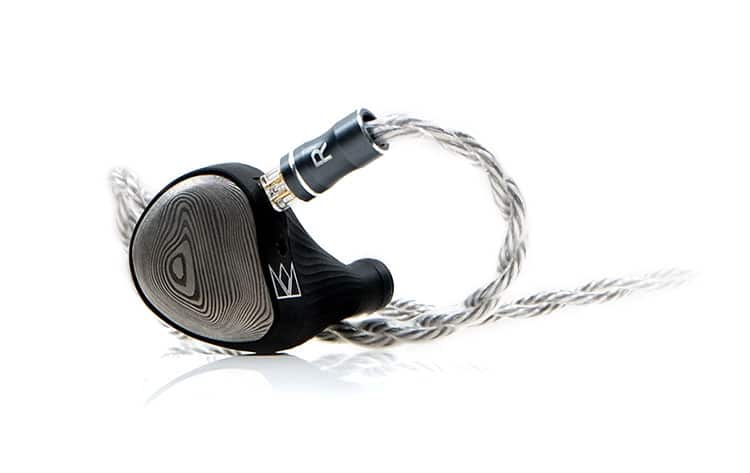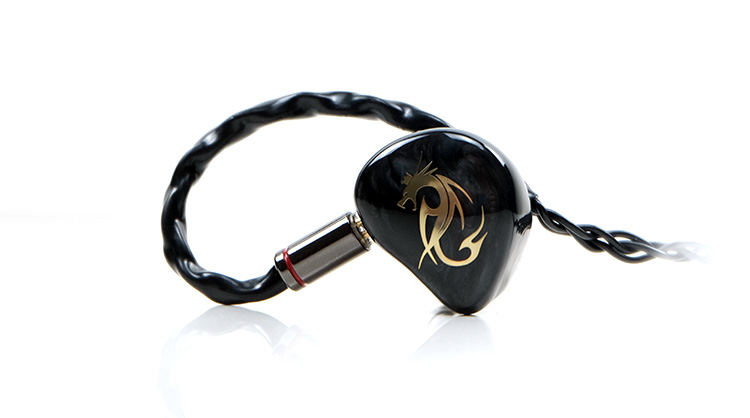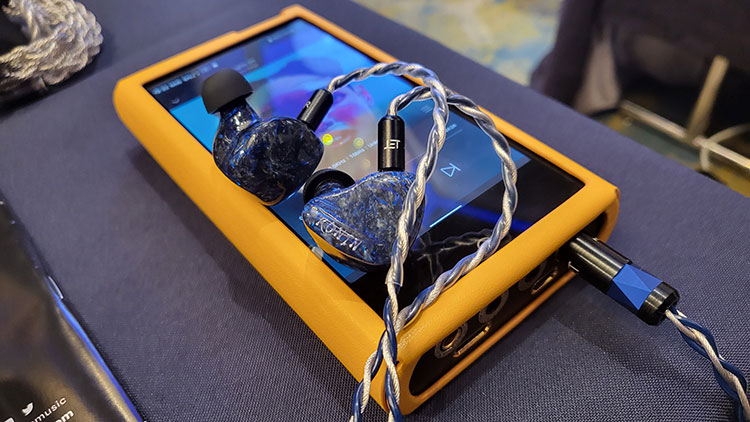Select Comparisons
The following comparisons were made using the HiBy RS8, the Luxury & Precision P6 Pro, and the Cayin N8ii as our main sources. All compared IEMs were using their stock cables and tips with the Noble Audio Ronin using the blue stem wide bore single flange silicone tips.
Noble Audio Viking Ragnar
The Noble Audio Viking Ragnar is the current headline monitor of the company’s flagship series. We reviewed it last year and it won our Top Gear Award for the same year for Best Universal IEM.
Technical
Both IEMs are hybrid universal IEMs, however, the mix of drivers and the configuration is different. The Viking Ragnar consists of 10 drivers in total with a tribrid mix of dynamic drivers, balanced armatures, and electrostatic.
The precise configuration is a dual 10mm dynamic driver setup for the lows, dual BA for the mids, dual BA for the mid-highs, and a Sonion quad electrostatic array for the highs.
The Ronin drops the dynamic drivers and goes with a larger BA count combined with electrostatic. The specific driver grouping is 4 Sonion BA drivers for the sub-bass and bass, 4 Knowles full-range drivers for the lower mids and mids, and a quad driver EST array for the highs and super highs.
Both monitors use crossover technology. The Ragnar uses a 4-way and the Ronin a 5-way with the Ragnar rated at a reasonable 17Ω impedance and 112 dB @1kHz sensitivity. You get a similar level from the Ronin which is also rated at 17Ω but just a little more sensitive at 114 dB @1kHz for SPL.
Design
Each in a way represents the two fundamental Noble IEM design languages that have evolved over the last number of years.
The Viking Ragnar’s robust aluminum alloy shell and intricate Damascus steel plating have their origins from the unibody through to the Sultan. Whereas the Ronin’s lighter resin shell complete with its complex swirl of blues, black and speckled finish has its origins from the Wizard’s Prestige CNC milling process.
Very different approaches and aesthetics. The Viking Ragnar is smaller but more robust and heavier whereas the Ronin is much lighter but the bigger of the two form factors.
They both still look like Noble Audio creations though. There is some overlap such as the extended spout and mesh guard tip as well as both using 0.78mm 2-pin sockets. They have that shared flared or elongated form factor also despite the different sizes.
Since the Ronin does not use dynamic drivers there is no venting in the shell similar to the Ragnar so isolation-wise it is a little bit superior. It also has an edge in comfort levels given it is lighter though from a 3rd party perspective the smaller Ragnar is lower profile in your ear.
Both IEMs have excellent cables with the Ragnar using the Wagner collaborated Magnus which is graphene, monocrystalline silver, and a copper-silver alloy wire. The Ronin uses the Eletech-partnered “Ronin” cable consisting of Gold Plated OCC, OCC Copper, and silver-plated OCC Copper.
Both are 4-wire creations and for the samples here both are balanced 4.4mm finished with 2-pin connectors. The Magnus is a bit on the bigger side physically from its softer but thicker TPU jacket whereas the thinner and lighter Eletech cable is a little firmer in its handling. Both handle really well with low microphonics and no memory retention.
Performance
In a funny way, each gives you something that is perhaps missing on the other so it is arguable the two complement each other rather than compete for the same ground.
The Viking Ragnar is more grandiose, stronger on the sub-bass, lighter on the mids body and forwardness as well as delivering more treble energy and presence. It’s a holographic spacious sound with more contrast in the tone and for most a slightly cooler timbre.
The Ronin is punchier in the mid-bass, smoother, and warmer through the mids with a stronger vocal presence and a more relaxed treble tuning. It can be spacious but it’s more about the micro-detail and the imaging interplay with an almost effortless delivery.
I personally think the timbral weight combined with the treble influence will sway you to either the Ronin or the Viking Ragnar. If you are a lover of vocals the Ronin is the better choice as the Ragnar sits them further back, which in turn amplifies that perception of enhanced staging space.
If you require something with more height, a firmer fundamental, and a cleaner timbre then I would pick the Ragnar. I still give the edge to the Viking Ragnar for absolute staging headroom just those richer mids on the Ronin really come to the fore in this comparison.
You can also hear the difference between the drivers on the low end. The Ronin’s mid-bass punch hits harder but if you want real depth the Viking Ragnar tuning is heavier on the sub-bass with improved texture and presence and a high level of bass to mids separation.
The BA woofers on the Ronin just drop a shade in presence below 50Hz but do better in terms of speed around 80-100Hz as you would expect a BA driver to do.
Noble Audio Kublai Khan
The Noble Audio Kublai Khan was launched in 2022 with our review coming at the start of this year. Like the Ronin, it is also part of the company’s flagship series of IEMs.
Technical
Another hybrid IEM that uses dynamic drivers, the Kublai Khan mixes it up a little by throwing bone conduction into the mix.
Unlike the Ronin, there are no Sonion drivers, just pure Knowles this time around with a 10mm dynamic driver for the lows, 2 Knowles BA for the low to mids, and 2 Knowles BA for the mid to highs.
The Ronin uses 4 Sonion BA drivers for the sub-bass and bass so the response will be quite different but it is ‘fleshier’ for the mids and highs with 4 Knowles full-range drivers for the lower mids and mids
The Kublai Khan uses a new generation ceramic 10mm Piezoelectric super tweeter for the highs to the ultra-highs as opposed to a Sonion EST array inside the Ronin for the highs and ultra-highs.
The bone conduction driver inside the Kublai Khan covers a low-frequency range and targets the dynamic driver and low-end presentation. You can see it physically up against the shell wall on the inner top side.
There is no specific complete data for the Kublai Khan driver rating, just that it is under 30Ω whereas the Ronin is fully spec’ed at 17Ω and 114 dB @1kHz for its SPL. Using a HiBy RS8 balanced output in low gain the Ronin is the more sensitive of the two monitors when volume matched but both are easy enough to drive in their own right.
Design
The design language of these two is closer to each other compared to the Sultan or the Ragnar. Both use a lightweight resin-type material and both use a stainless-steel finish to their respective spouts with mesh guards.
The level of finishing and aesthetic on the Ronin is a notch higher for me with that blue and speckle finish throughout whereas the Kublai Khan is a plain black resin shell combined with a more striking faceplate. The contouring on the body is also a shade more aggressive on the Ronin.
The form factor is also very similar save for the depth of the shell towards the rear with the Ronin noticeably deeper and the Kublai Khan tapering off a bit more. It does give a sensation of being bigger than the Khan though side by side the plate-to-spout length is more or less the same.
Using the same blue stem tips, I felt the Kublai Khan sealed and isolated almost as well as the Ronin. I suspect I am able to get the Khan a little bit deeper given its slightly flatter underside and that does make a difference. Both isolate very well indeed but I had expected the Khan’s vented shell to leak a bit more.
The Ronin’s Eletech collaboration cable is a setup on the Kublai Khan’s stock Noble Premium cable in terms of wire materials used and external finishing.
The Kublai Khan uses a 1.2m 26AWG 8-core OCC wire which does double the core count over the Ronin’s 4-wire Gold Plated OCC, OCC Copper, and silver-plated OCC Copper design.
However, the geometry is a little simpler, and the finishing, though very competent, is less premium-looking compared to the lighter and more intricate design of the Ronin cable.
Performance
There is a similar high-level sound signature contrast between the Kublai Khan and the Ronin in terms of what we found in the Ragnar comparison.
The key FR differences here are the amplified bass weight of the Kublai Khan sub-bass which is stronger and the heightened physicality and presence of the piezoelectric driver highs compared to the relatively relaxed tuning of the Ronin EST drivers.
The Ronin has that mid-bass punch and speed but it will not compare to the Kublai Khan’s deeper sub-bass rumble and dynamic driver texture.
In between, the Ronin midrange sounds firmer and warmer in its tone as well as imaging further forward with vocals front and center.
The Kublai Khan has a bump from 1-3k but it’s milder with vocals sitting back a little in comparison. The timbre is much cleaner, but also thinner with more emphasis on the bass fundamental to underpin midrange notes and treble energy on the overtone.
The Ronin only has a mild treble peak around 5k to 6k whereas the Kublai Khan is much firmer around 5-8k. That does color the treble timbre a bit more adding heightened contrast and more sparkle. However, headroom on the Ronin is just as good with a bit more, albeit subtle, upper treble extension from those EST drivers.
Overall, Kublai Khan is more extended in terms of depth and perceived energy in the highs, great for EDM and synthwave. However, the more complex and balanced presentation comes from Ronin. Not as ‘explosive’ per se but more coherent delivering a very natural and engaging midrange for vocal lovers.
Noble Audio Sultan
The Noble Audio Sultan is the final monitor in the company’s Flagship series line-up to be compared here but it was also the first of the group to be launched back in 2020.
Technical
In many ways, the Sultan is the genesis of the Viking Ragnar, Kublai Khan, and the Ronin. It is the first monitor in their line-up to use EST drivers as well as use a type of build and design now seen in the Ragnar.
Inside, you have perhaps a more humble 7 drivers as opposed to 12 in the Ronin, with a mix of dynamic, BA, and EST. The precise grouping is a 10mm dynamic driver for the lows and 4 BA drivers for the mids and a gen 1 Sonion dual electrostatic driver and transformer combo.
The Ronin has no dynamic but a lot more BA complexity with 4 Sonion BA drivers for the sub-bass and bass, 4 Knowles full-range drivers for the lower mids and mids, and a 2nd generation quad driver EST array for the highs and super highs.
Noble doesn’t officially reveal either of the monitor’s impedance or sensitivity ratings but from what I gather the Sultan has been measured around 11-12Ω with a 115.47 dB/mW SPL.
That competes quite well with the Ronin’s 17Ω and 114 dB/mW SPL but just bear in mind the 1st gen Sonion EST energizers are less efficient than the Ronin’s second-gen version. In our real-world testing with the LP P6 Pro, this showed up as a slight gap in loudness between the two when the volume matched with the Sultan the quieter.
Design
The Sultan’s design closely resembles the Viking Ragnar as opposed to the Ronin or the Kublai Khan.
The key differences lie in the precise material choices and the finishing with a Galaxy swirl-type amber facade for the faceplate on top of the ribbed shells cut from a single aluminum block and finished in anodized two-tone silver and charcoal colors.
It’s a heavier shell compared to the Ronin and probably more robust for knocks in everyday use. The Sultan has less contouring to fit smoothly into the ear but it’s far smaller than the Ronin with the net result that it is a lower-profile fitting in your ear but one that is quite dependent on the tips to get a secure and comfortable seal.
Given the smaller profile and general performance, I have tended to use the larger off-white foam tips with the Sultan and they do isolate quite well. However, the lack of venting on the Ronin and the better contouring gives you a tighter fit and better isolation performance, even with the softer silicone tips.
The Sultan uses the same Noble Audio stock 1.2m 8-core OCC wire cable as the Kublai Khan and honestly, I have no complaints about how it handles and how it is finished. It is a supple cable with non-existent memory retention throughout with complimentary dark-themed barrels and splitters.
However, the Eletech design “Ronin” cable, despite being a 4-wire does offer a much lighter wearing experience, a similar sonic performance, and presented with a more intricate and premium-looking finish to both the cable and the barrels. It is also arguable the mix of wire materials inside the stock Ronin cable is also a setup up in quality.
Performance
It is arguable that the Sultan and Ronin are closer bedfellows by aiming for a similar coherent timbral overtone. Both are on the natural or warmer side compared to Ragnar and Kublai Khan which are more dynamic and cooler sounding.
However, it’s really on the technical side where you can see much of the progression Noble has done in terms of delivering a ‘flagship sound’. The Ronin is more resolving and more expansive. It has better imaging complexity delivering a more spacious and holographic soundstage.
The Sultan aims for the touch points of strong bass, good vocals, and a smattering of sparkle on top but otherwise, it can feel a little more closed in. There is a slight abruptness to the limits of its outward staging compared to the more effortless Ronin delivery.
It also does not have the same level of intricate layering capability as the Ronin which only adds to that comparatively flatter presentation.
The Sultan’s dynamic driver does affect the bass delivery giving it a much thicker and slightly slower transient but also a weightier sub-bass presence and a stronger fundamental to go along with it. It does give it a satisfying level of heft and more power than the Ronin’s flatter bass tuning.
However, once you go into the mids, the more forward tuning of the Ronin delivers a fuller richer tone to both vocal and instrument with the Sultan sound the thinner of the two and more neutral in terms of imaging.
Noble has also nailed the treble tuning on the Ronin giving it a very natural tone and not pushing too hard beyond the upper-mids. The Sultan comes relatively close but there is a 7-8k peak there that can push a little more uneven brightness into the mids timbre.
Our Verdict
The Noble Audio Ronin is the company’s most balanced and detailed-sounding monitor to date. It is also one of their most accessible tunings with a natural tuning that makes it a non-fatiguing pleasure to listen to.
Dynamic driver lovers might miss the slightly rolled-off sub-bass weight. If you need more rumble then there is always the Kublai Khan and the Ragnar if you need the complete arena experience.
For vocal lovers though the Ronin is a real treat. The magic here is in the mids with an abundance of detail delivered in an effortless fashion.
Noble Audio Ronin Specifications
- 4 Sonion Balanced Armature Drivers (sub-bass/mid-bass)
- 4 Knowles Balanced Armature Drivers (mid/highs)
- 4 Electrostatic Sonion drivers (high/super highs)
- 5-Way Crossover
- Sensitivity:114dB SPL/mW
- Resistance:17Ω
Includes Eletech Custom 7-core cable
- 2-pin connectors, 4.4mm Pentaconn termination
- 26 AWG, 4 Wires
- Gold Plated OCC + Copper & Silver Plated Copper
- 7 Interior Core Litz
- OFC Silver Plated Shielding
- Eletech Custom Connectors and Y-Split





